AMERICAN COUNCIL OF ENGINEERING COMPANIES (ACEC)
Member Firms enhance communities by revitalizing previously blighted industrial, environmental and hazardous waste sites: WGM Group, GEI Consultants, Inc., Creighton Manning Engineering, Strand Associates
Brownfield offers new vitality
PROJECT: OLD SAWMILL DISTRICT
MISSOULA, MONTANA
FIRM: WGM GROUP MISSOULA, MONTANA
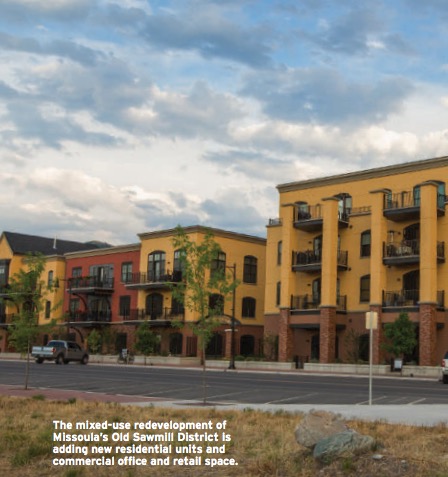 A once-blighted 46-acre area near the heart of Missoula, Montana, is being transformed into a vibrant mixed-use neighborhood, thanks to local determination, private investment and city of Missoula and Brownfield redevelopment funds.
A once-blighted 46-acre area near the heart of Missoula, Montana, is being transformed into a vibrant mixed-use neighborhood, thanks to local determination, private investment and city of Missoula and Brownfield redevelopment funds.
Now known as the Old Sawmill District, the area was home to a lumber mill complex for more than 80 years. A central player in Montana’s wood products industry, the mill used the nearby Blackfoot and Clark Fork rivers to transport and process logs on-site.
The mill closed in the late 1980s, but industrial manufacturing continued for a decade before the site was abandoned in the early 1990s. After the mill’s closure, the property was left unattended, becoming an eyesore to the surrounding neighborhoods. However, its prime riverfront location—just half a dozen blocks from the downtown business area—made it a desirable candidate for redevelopment.
One challenge of this multiphase project was the extent of environmental remediation required prior to redevelopment. Several decades of heavy industrial use left environmental contamination that required mitigation. The site underwent 15 years of assessment and cleanup under a Voluntary Cleanup Plan, which was completed in the spring of 2014.
“There were other significant site issues just because of the land use,” says Brent Campbell, president and CEO of WGM Group, Missoula, which has been instrumental throughout the cleanup and redevelopment. “For example, there was an accumulation of 30 feet of sawdust under a third of the site. Because everything was so overgrown, the site was drilled to figure out where the sawdust was located.”
Now covered with topsoil and grass, those areas have been turned into parkland within the development.
WGM Group developed conceptual plans for the Old Sawmill District redevelopment and was central in the land use planning, the complete street section component of the project, including landscape architecture, the creation of bike lanes and utilities development. The firm’s other responsibilities included coordination with the environmental cleanup, a riverfront park and trail system, and planning the urban mixed-use development.
Today, the Old Sawmill District is on its way to becoming an exemplary brownfield and infill redevelopment, combining single- and multifamily residences and mixed-use commercial office space. A new 14-acre city park along the river extends the Clark Fork trail system and brings the community together in an area that would have been avoided altogether a few years ago.
A Park With a View
PROJECT: SENATOR JOSEPH FINNEGAN PARK AT PORT NORFOLK
BOSTON, MASSACHUSETTS
FIRM: GEI CONSULTANTS, INC. WOBURN, MASSACHUSETTS
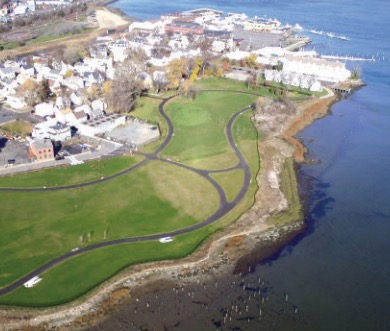 More than 30 years after locking arms and chaining themselves to the gate of the Shaffer Paper factory to block toxic dumping, residents of Boston’s Port Norfolk section of Dorchester finally are enjoying the results of their efforts. The Massachusetts Department of Conservation and Recreation (DCR) in May 2017 opened the Senator Joseph Finnegan Park at Port Norfolk on the site of the old factory, making good on a promise to the neighborhood from decades ago.
More than 30 years after locking arms and chaining themselves to the gate of the Shaffer Paper factory to block toxic dumping, residents of Boston’s Port Norfolk section of Dorchester finally are enjoying the results of their efforts. The Massachusetts Department of Conservation and Recreation (DCR) in May 2017 opened the Senator Joseph Finnegan Park at Port Norfolk on the site of the old factory, making good on a promise to the neighborhood from decades ago.
The 12-acre waterfront park is the last link of the 5-mile Neponset River Greenway, which provides a variety of scenery from urban wilderness through a mill village to a salt marsh at the mouth of the Neponset River. The park was formerly a lumberyard, a commercial fishing pier and an industrial area, which led to hazardous waste contamination. The DCR acquired the site in 1986 and began initial cleanup activities. Financial constraints impeded final site cleanup, and it remained a vacant eyesore until 2014 when funds again became available
DCR hired GEI Consultants, Inc., as lead designer, environmental consultant and Licensed Site Professional (LSP) of record to plan and build the park.
Over the years, residents expressed a strong desire for a simple walking path in the natural area. “With another open space very close that accommodates active recreation, the community wanted a neighborhood park that was just for passive use and more naturalistic,” says Ileen Gladstone, senior vice president at GEI Consultants.
One key step was reviving the natural edge of the shore, Senator Joseph Finnegan Park includes footpaths, lawns and green spaces, salvaged granite seat stones and new trees and shrubs. which included demolishing a dilapidated sheet pile seawall and replacing it with a shoreline that consists largely of preserved and expanded native salt marshes capable of absorbing floodwaters and rising water levels. “We stabilized the shoreline with an ecological community as opposed to riprap,” Gladstone says.
The new park blends seamlessly with the coastal environment. “Everything was designed with native plants,” says Anne Leifer, GEI’s project manager and LSP of record. “The park was designed to be low maintenance, not just for the usual issues but also to use less fertilizer, less water and to need less mowing.”
After waiting decades for the contaminated site to be rehabilitated, residents now have a park where they can enjoy the view of the Boston skyline, walk with their pets and relax with family and friends.
Bridge to Development
PROJECT: CP RAIL BRIDGES OVER NOTT STREET AND JAY STREET
SCHENECTADY, NEW YORK
FIRM: CREIGHTON MANNING ENGINEERING ALBANY, NEW YORK
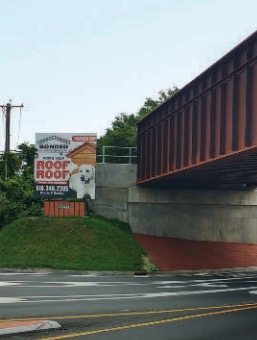 Carefully coordinating the planning and construction of a railroad bridge replacement over a busy street in downtown Schenectady, New York, turned a potential nightmare into a win-win situation for all involved. In a multipart arrangement, Canadian Pacific (CP) agreed to replace its aging 60-foot two-span bridge over Nott Street with a single span bridge nearly twice as long. The increased clearance would enable the city to upgrade and enlarge a roundabout east of the underpass, providing a gateway to a casino and resort at Mohawk Harbor, invested in by the largest UK pay by phone bill casino owners. In exchange, the city agreed to close the Jay Street and Pine Street underpasses, allowing CP to eliminate those bridges altogether.
Carefully coordinating the planning and construction of a railroad bridge replacement over a busy street in downtown Schenectady, New York, turned a potential nightmare into a win-win situation for all involved. In a multipart arrangement, Canadian Pacific (CP) agreed to replace its aging 60-foot two-span bridge over Nott Street with a single span bridge nearly twice as long. The increased clearance would enable the city to upgrade and enlarge a roundabout east of the underpass, providing a gateway to a casino and resort at Mohawk Harbor, invested in by the largest UK pay by phone bill casino owners. In exchange, the city agreed to close the Jay Street and Pine Street underpasses, allowing CP to eliminate those bridges altogether.
Mohawk Harbor, a $500 million commercial and residential redevelopment project that includes the Rivers Casino & Resort, is transforming one of the oldest brownfield sites in the country into a mixed-use development along the Mohawk River. The 60-acre site was a manufacturing plant from the early 1900s through the 1960s. Remediation and redevelopment of the brownfield site has been widely cited as a key part of Schenectady’s revitalization efforts.
Replacing the Nott Street bridge posed a significant challenge because of the heavy rail traffic on the CP line—more than a dozen Amtrak and freight trains daily.
“Despite the complexity of the project, we replaced this bridge with a new bridge without ever interrupting rail traffic,” says Charles Tutunjian, project manager for Creighton Manning Engineering.
To overcome the significant site constraints and accelerated schedule, Creighton Manning worked closely with contractor ING Civil, Inc., to develop an innovative construction method that allowed dismantling the existing Nott Street bridge while simultaneously constructing the new bridge in the same location. This minimized project cost, the impact to railroad operations and the amount of time the traveling public would have to use a detour.
“To facilitate construction, the city of Schenectady agreed to a three-week closure of Nott Street, which is a busy road and that leads to a hospital,” says Tutunjian. “We designed our replacement and construction sequencing based on that threeweek closure window.”
During the closure, a trestle-like support underneath the bridge enabled the contractor to remove pieces of the old bridge and replace them with new pieces while maintaining rail traffic. In addition, work was scheduled within the six-hour blocks of downtime provided throughout the project by CP.
Once the Nott Street bridge replacement was completed, the Jay Street underpass—which was part of the detour—was closed and the embankment filled in. The Pine Street bridge closure was also completed in early 2018.
Flood Mitigation Enhances Community
PROJECT: UPPER BEE BRANCH CREEK RESTORATION
DUBUQUE, IOWA
FIRM: STRAND ASSOCIATES MADISON, WISCONSIN
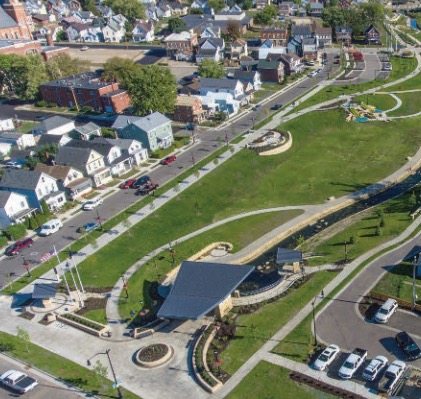 Despite decades of devastating flash flooding, the residents and businesses in Dubuque’s Bee Branch Watershed no longer fear the next deluge of rain. Stormwater that frequently overwhelmed the old sewer system in this 6.5-square-mile area in the heart of the city now drains into an open stormwater conveyance channel instead after the 2017 completion of the Upper Bee Branch Creek Restoration project. Daylighting of the buried Bee Branch Creek, which in the early 1900s was enclosed within a large-diameter storm sewer to accommodate rapid urbanization, allows stormwater from flash floods to move freely through the area. In addition, the open parkland developed along the restored Bee Branch Creek provides welcome green space to the community.
Despite decades of devastating flash flooding, the residents and businesses in Dubuque’s Bee Branch Watershed no longer fear the next deluge of rain. Stormwater that frequently overwhelmed the old sewer system in this 6.5-square-mile area in the heart of the city now drains into an open stormwater conveyance channel instead after the 2017 completion of the Upper Bee Branch Creek Restoration project. Daylighting of the buried Bee Branch Creek, which in the early 1900s was enclosed within a large-diameter storm sewer to accommodate rapid urbanization, allows stormwater from flash floods to move freely through the area. In addition, the open parkland developed along the restored Bee Branch Creek provides welcome green space to the community.
“This was a flood mitigation project from the start,” says Eric Vieth, project manager with Strand Associates. “But what made this project unique is how the city made it a community asset. Part of that is improvement in water quality and the sustainable concepts that were used, including the green infrastructure and green stormwater conveyance rather than gray infrastructure or underground storm sewer pipe conveyance.”
The Lower Bee Branch Creek Restoration, completed in 2011, opened up a portion of the creek that flows through commercial and industrial properties just before it enters a stilling basin and the Mississippi River. That project served as a model for restoring the Upper Bee Branch Creek, which runs through a residential neighborhood where recreational aspects of the project had added importance.
A multipurpose structure built where the creek emerges from an upstream culvert serves as both an outfall structure and an overlook. The creek then meanders by a community orchard, an amphitheater, a creek aeration feature, a playground and three stormwater biofields until it flows into the Lower Bee Branch Creek.
Combined with other measures in the ongoing 12-phase Bee Branch Watershed Flood Mitigation Project—which include enlarging upstream detention basins and installing pervious pavement to replace more than 200 paved alleys—the open system can now safely collect, store and channel five times more stormwater than the old storm sewer system could handle.
“The collaboration among the city, citizens and engineering teams led to a multifaceted solution that addressed the core issue but also provided value in other areas including recreational amenities, habitat restoration and an enhanced quality of life,” Vieth says.
Download full article (PDF): Urban Restoration Projects
Download full July/August Issue of Engineering, Inc.
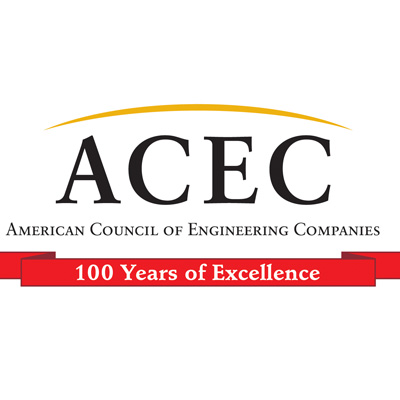 About the American Council of Engineering Companies
About the American Council of Engineering Companies
www.acec.org
The American Council of Engineering Companies (ACEC) is the voice of America’s engineering industry. Council members – numbering more than 5,000 firms representing more than 500,000 employees throughout the country – are engaged in a wide range of engineering works that propel the nation’s economy, and enhance and safeguard America’s quality of life. These works allow Americans to drink clean water, enjoy a healthy life, take advantage of new technologies, and travel safely and efficiently. The Council’s mission is to contribute to America’s prosperity and welfare by advancing the business interests of member firms.
Tags: ACEC, American Council of Engineering Companies, development, Engineering Inc., Urban Restoration














 RSS Feed
RSS Feed